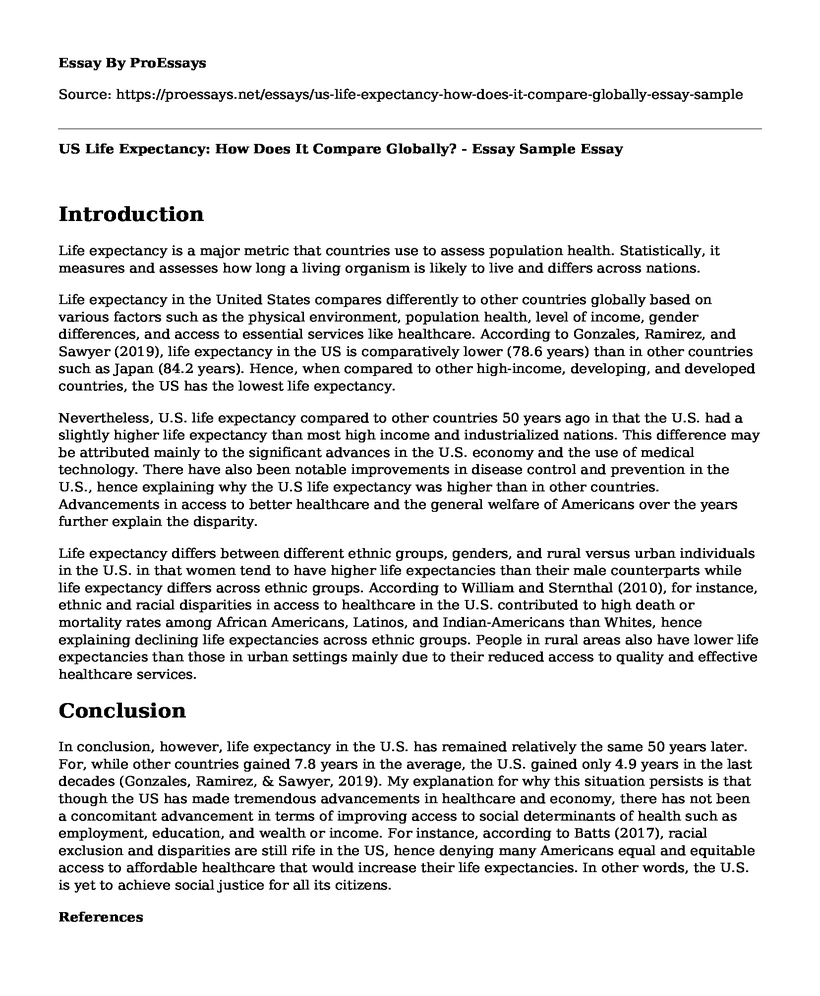Introduction
Life expectancy is a major metric that countries use to assess population health. Statistically, it measures and assesses how long a living organism is likely to live and differs across nations.
Life expectancy in the United States compares differently to other countries globally based on various factors such as the physical environment, population health, level of income, gender differences, and access to essential services like healthcare. According to Gonzales, Ramirez, and Sawyer (2019), life expectancy in the US is comparatively lower (78.6 years) than in other countries such as Japan (84.2 years). Hence, when compared to other high-income, developing, and developed countries, the US has the lowest life expectancy.
Nevertheless, U.S. life expectancy compared to other countries 50 years ago in that the U.S. had a slightly higher life expectancy than most high income and industrialized nations. This difference may be attributed mainly to the significant advances in the U.S. economy and the use of medical technology. There have also been notable improvements in disease control and prevention in the U.S., hence explaining why the U.S life expectancy was higher than in other countries. Advancements in access to better healthcare and the general welfare of Americans over the years further explain the disparity.
Life expectancy differs between different ethnic groups, genders, and rural versus urban individuals in the U.S. in that women tend to have higher life expectancies than their male counterparts while life expectancy differs across ethnic groups. According to William and Sternthal (2010), for instance, ethnic and racial disparities in access to healthcare in the U.S. contributed to high death or mortality rates among African Americans, Latinos, and Indian-Americans than Whites, hence explaining declining life expectancies across ethnic groups. People in rural areas also have lower life expectancies than those in urban settings mainly due to their reduced access to quality and effective healthcare services.
Conclusion
In conclusion, however, life expectancy in the U.S. has remained relatively the same 50 years later. For, while other countries gained 7.8 years in the average, the U.S. gained only 4.9 years in the last decades (Gonzales, Ramirez, & Sawyer, 2019). My explanation for why this situation persists is that though the US has made tremendous advancements in healthcare and economy, there has not been a concomitant advancement in terms of improving access to social determinants of health such as employment, education, and wealth or income. For instance, according to Batts (2017), racial exclusion and disparities are still rife in the US, hence denying many Americans equal and equitable access to affordable healthcare that would increase their life expectancies. In other words, the U.S. is yet to achieve social justice for all its citizens.
References
Batts, V. (2017). Is reconciliation possible? The question remains bridging troubled waters: Lessons from combating "modern racism" in the US and South Africa. Retrieved from https://www.visions-inc.org/uploads/1/1/7/0/117018765/is-reconciliation-possible-july-2017-3.pdf.
Gonzales, S., Ramirez, M., & Sawyer, B. (2019). How does U.S. life expectancy compare to other countries?HealthSystemTracker.Retrievedfromhttps://www.healthsystemtracker.org/chart-collection/u-s-life-expectancy-compare-countries/#item-le_life-expectancy-at-birth-in-years-2017_dec-2019-update
Williams, D.R., & Sternthal, M. (2010). Understanding racial/ethnic disparities in health: Sociological contributions. Journal of Social Behavior, 51, 15-27. doi:10.1177/0022146510383838
Cite this page
US Life Expectancy: How Does It Compare Globally? - Essay Sample. (2023, May 03). Retrieved from https://proessays.net/essays/us-life-expectancy-how-does-it-compare-globally-essay-sample
If you are the original author of this essay and no longer wish to have it published on the ProEssays website, please click below to request its removal:
- Course Work on Nutritional Health
- Statistics for the Behavioural Sciences Paper Example
- Essay Sample on Medical Standards of Ethics
- Literary Analysis Essay on Social Work with Immigration and Refugee
- Essay Sample on HPV Education and Vaccination
- COVID-19: Strategies for Preparing for Pandemic Outbreaks in Chicago - Essay Sample
- Free Essay Example on Cultural Behaviors: Examining the Impact of Ethnicity & Other Factors







